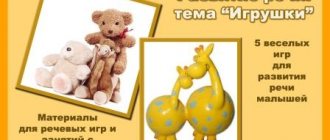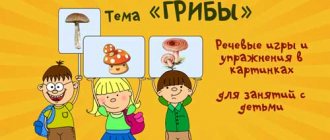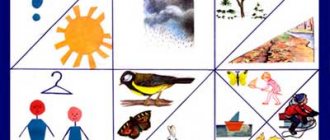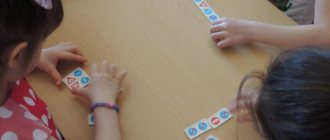Recommendations for conducting classes
If you want to use pictures of mushrooms for activities with children, then you should consider several rules for their use:
- Give your child the opportunity to take a good look and study new images in each drawing, and only then use them for educational exercises or games.
- Pay attention to the quality of the pictures. It is best to use special speech therapy illustration sets produced for kindergarten, but you can also take realistic images from the Internet or use photographs.
- Be sure to select a variety of handouts - both subject pictures and plot ones. The first are small cards with single images of mushrooms, and the second are illustrations of a real (hedgehog with mushrooms) or fairy-tale (series of pictures Under a mushroom) situation on the topic. For the development of speech in preschoolers, both types of visual material are necessary.
- Any illustration for classes must be made in a realistic manner, accurately repeating all the elements of the external structure of a particular object.
- It is most convenient to use cards with names that older preschoolers can read themselves.
- Images of mushrooms on a transparent background significantly expand the possibilities of using them when composing stories.
Cards by Glen Doman on the topic “Mushrooms”:
OIL CAN
A chocolate-brown mushroom, the leaf stuck to the slippery cap.
Thin openwork collar -
This mushroom is called butterdish.
(E. Savelyeva)
Butterflies are tubular mushrooms from the genus Maslenika. In most species, the skin is slimy and easily removed from the cap.
In English-speaking countries this mushroom is called “slippery Jack”, in Germany - “butter mushroom”, in the Czech Republic - “butter mushroom”.
In some butterfish, the tubular layer is covered from below with a thin film. It is called a private veil. As the mushroom matures, it is destroyed, its remainder can be found on the stem in the form of a filmy ring. The flesh of butternut squash is yellowish, slightly pinker when cut. Has a pleasant soft pine aroma.
In pine and mixed forests, boletus grows in large families almost all summer until the autumn frosts. Butterflies are common in Eurasia, America, and Australia. The most common types of oiler are true, granular, and larch.
The butterdish is a noticeable mushroom, the height of the stem is 3-8 cm, and the width of the cap is 5-10 cm. Small mushrooms are hidden under the needles and can only be discovered when they grow a little. Butter is used both fresh and for pickling. The skin of the cap is usually removed. To do this better, immerse the mushrooms in boiling water for 1-2 minutes or keep them over steam. Most types of buttermilk practically do not differ from each other in taste. Butternuts are usually not dried because after drying they become rock hard. They fry or prepare soup from summer harvests, but autumn harvests are better suited for pickling and pickling, because they are denser and more elastic, and do not spoil for a long time.
The genus Shrovetide includes two more types of mushrooms: goat mushroom and pepper mushroom. The goat is edible, but of low quality. Pepper mushroom has a bitter taste, so it is not usually collected. Some fans use it as a seasoning.
The sheep mushroom is very similar to the oiler. But the bottom of the oiler's cap is light yellow, and the lamb's cap is brick red.
MYSTERY
The boy is standing -
The cap is dirty.
(Oil Can)
TRUFFLE
Truffles are found in relatively warm temperate regions of both hemispheres. The fleshy fruiting bodies of mushrooms are round in shape and covered with warty or smooth skin. The size ranges from a pea to a large potato tuber and even larger, and the weight of some mushrooms reaches 1 kg. The most valuable, black truffle grows in beech and oak forests in the south of France, northern Italy, and less commonly in Germany. The capital of the black truffle is the French province of Périgord. The most valuable - white truffle - is found in Italian Piedmont. Recently, a large number of truffle varieties have been discovered in the forests of Australia. Moreover, their number is growing as new territories are explored.
Truffles are very expensive mushrooms. This is explained by their exquisite taste, which is so appreciated by gourmets.
How do truffles, whose fruiting bodies are located underground, spread? These mushrooms are food for some animals, such as pigs. They eat fruiting bodies along with the spores they contain. The spores pass unharmed through the intestines and are spread throughout the forest along with feces. In the forests of Australia, about 40 species of mammals spread truffles. The endangered potorous spends most of its active life searching for truffles. In the coniferous forests of the United States, truffles are eaten mainly by rodents. Animals search for truffles by the specific smell characteristic of each type of these mushrooms. People use specially trained pigs and dogs to search for the delicious black truffle. Avid mushroom pickers find truffles by a well-known sign: midges often swarm over these mushrooms.
In the 18th century The French taught the Russians to “hunt” truffles in the forests near Moscow. The “hunt” was staged on a grand scale - entire villages lived by collecting truffles. Russian men taught little bear cubs how to find truffles. In good years, up to 5,000 tons of truffles were collected in the Moscow region. After the revolution, the truffle sites were lost and have not yet been restored.
Besides black, there are other types of truffles. White, or Trinity, truffle is found in the forests of Western Europe, Ukraine and Belarus. The fruit body of the white truffle has light flesh, similar in appearance and size to potatoes. Truffles grow not only in forests. Steppe truffles are called "tombolans". Some of them are also edible. They are found in the steppe regions of Southern Europe, North Africa and on the shores of the Caspian Sea - in Azerbaijan and Turkmenistan.
Games
Different pictures of mushrooms for children allow you to conduct many different kinds of speech therapy games. Here are some examples:
- Collecting mushrooms
Each player chooses one picture of a mushroom and tries to describe its external features. If the other player guesses right, the card goes to him. The one who collects the most pictures wins.
- How are we similar?
An adult chooses two cards (boletus-boletus, white-boletus, russula-fly agaric) and invites the children to see as many differences between them as possible. The last one to answer wins.
- Cheerful cooks
Invite the children to “cook” a lunch of different edible mushrooms that they know. Everyone must choose one picture and name a dish that can be prepared with one or another mushroom (for example: porcini mushroom soup, pickled boletus, boletus mushrooms in sour cream, salted milk mushrooms, etc.
- Oh, what a honey fungus we have!
The image of any mushroom is transmitted from one player to another. Everyone names one of its characteristics, distinctive features of the external structure. The winner is the participant who can see and name some detail last.
- Tales from storytellers
Ask each player to choose one specially selected picture of a mushroom for children. Then everyone must come up with a short story about their character. Tell about his character, habits, activities. For example, Borovik is the king of all mushrooms in the forest, he is strict and important, busy with government affairs from morning to evening, loves to play football and play the balalaika. Older preschoolers can be asked to come up (in a circle) with a whole story about the mushroom kingdom; everyone can draw illustrations for the fairy tale together.
- Mosaic: find a piece
Make cut-out pictures from the cards and invite your child to assemble them. You can use drawings of poisonous and edible mushrooms for this game.
- Full basket
Invite your child to select several cards (he will need a small basket for this), memorize them well and repeat all the names by heart without looking into the basket again. Each player can try to become a mushroom picker by collecting their own set of cards.
Puzzles
It is very useful to teach riddles on a chosen topic with children. This helps not only to train the preschooler’s memory and attention, but also significantly increases his vocabulary, and also allows him to automate difficult sounds. Here is a selection of suitable riddles called Basket of Mushrooms for Kids:








